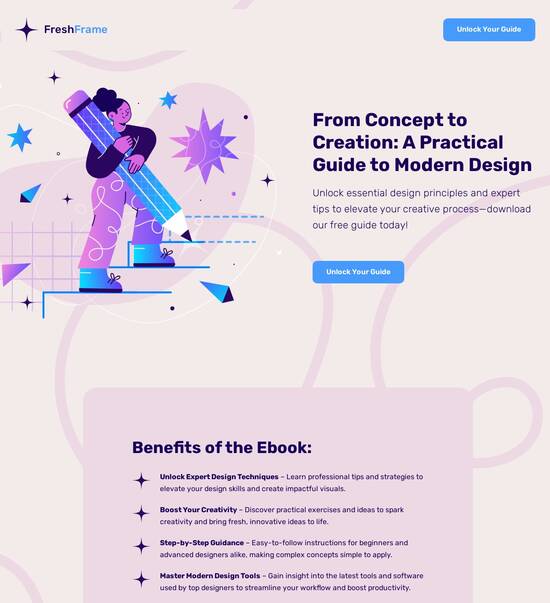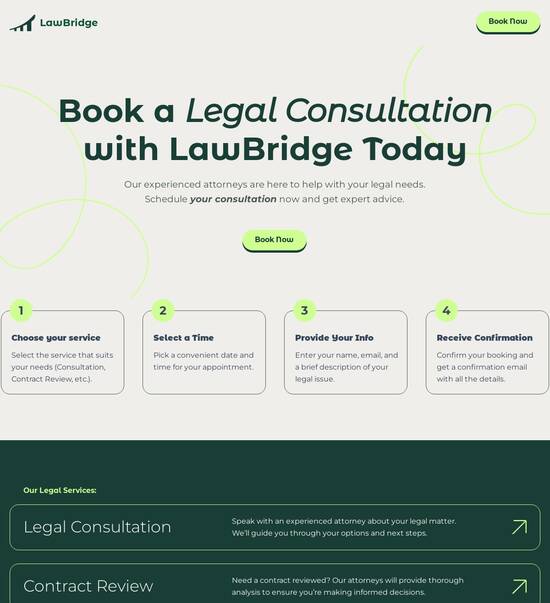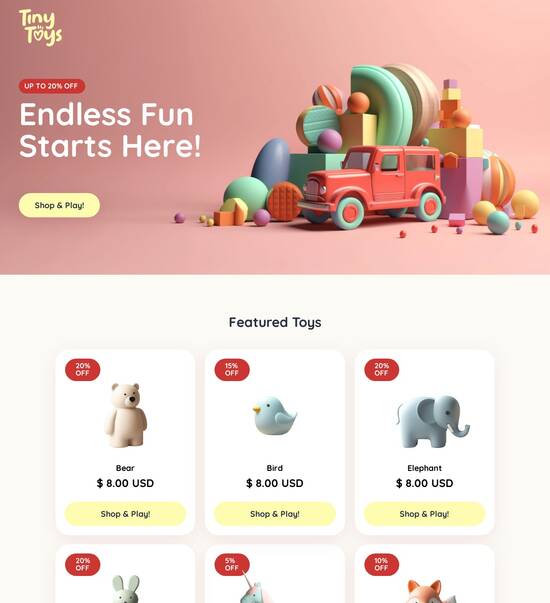
PWA product page templates
Use TemplateAbout template
Use PWA product page templates and stay true to your brand identity. Resonate with your audience today.
Recommended templates

Easy to build without coding
With the intuitive drag-and-drop builder, anyone on your team can create high-converting pages without any knowledge of code or design. Make enhancements to your landing page with custom widgets using Javascript, HTML/CSS, or third-party scripts.

Multiple layouts for any industry and goal
Select from 500+ landing page layouts built to boost conversions across industry-specific scenarios. Customize them by adjusting fonts, adding images, and generating on-brand content with the AI assistant. Quickly scale with Instablocks® and Global Blocks that you can save, reuse, and update globally.

Loads fast and looks polished on any device
Every template is responsive, which means they present professionally on any device and load blazingly fast with our Thor Render Engine. You can also power them up with Google AMP technology to deliver an unparalleled mobile experience and drive higher conversions.

Robust analytics & experimentation
Get real-time updates and reporting across all your devices, showing the number of visitors, conversions, cost-per-visitor, and cost-per-lead. Launch AI-powered experiments, run A/B tests, and use heatmaps to analyze user behavior, then optimize your landing page to maximize conversions.







Easy to build without coding
With the intuitive drag-and-drop builder, anyone on your team can create high-converting pages without any knowledge of code or design. Make enhancements to your landing page with custom widgets using Javascript, HTML/CSS, or third-party scripts.
Multiple layouts for any industry and goal
Select from 500+ landing page layouts built to boost conversions across industry-specific scenarios. Customize them by adjusting fonts, adding images, and generating on-brand content with the AI assistant. Quickly scale with Instablocks® and Global Blocks that you can save, reuse, and update globally.
Loads fast and looks polished on any device
Every template is responsive, which means they present professionally on any device and load blazingly fast with our Thor Render Engine.
Robust analytics & experimentation
Get real-time updates and reporting across all your devices, showing the number of visitors, conversions, cost-per-visitor, and cost-per-lead. Launch AI-powered experiments, run A/B tests, and use heatmaps to analyze user behavior, then optimize your landing page to maximize conversions.
All the features you need to build pwa template free download
Explore more featuresLearn how to build app store product page template
Frequently asked questions about pwa template
Leading the way in building high-performing landing pages





Template pwa: Your ultimate how-to guide
In the competitive landscape of digital marketing, leveraging an all-in-one landing page and CRO platform like Instapage can transform your marketing strategy. With Instapage, marketers in sectors such as business services, tech, and education can easily create customized landing pages that significantly enhance lead generation and conversion rates. Here's a step-by-step guide to utilizing Instapage for your next campaign.
Understanding the power of Instapage
Instapage offers a robust suite of features designed to streamline the landing page creation process. From over 100 templates to intuitive drag-and-drop builders, Instapage equips marketers to quickly deploy stunning pages tailored for various audiences. Here’s an overview of what you can do:
- Utilize high-converting templates: Choose from 100+ templates designed to maximize conversions.
- Leverage lead generation elements: Instapage provides essential tools like forms and pop-ups to capture leads effectively.
- No coding required: Build your pages effortlessly with user-friendly design tools.
Step 1: Create your landing page
Begin by selecting a template that aligns with your campaign goals. Customization is key to ensuring your landing page speaks directly to your audience's needs.
Step 2: Optimize for conversions
Once your page is set up, it’s crucial to engage in optimization practices. Implement A/B testing to analyze which elements perform best, and utilize heatmaps to assess user behavior.
- Conduct A/B tests: Test different headlines, images, and CTAs to see what resonates
- Analyze behavior: Heatmaps show where users click and scroll the most
- Utilize an analytics dashboard: Measure performance metrics to continue improving your pages
Step 3: Personalize the user experience
Delivering a personalized message can drastically improve your conversion rates. Use tools available on Instapage to dynamically change content based on user data.
- Dynamic text replacement: Tailor your message to reflect the user's search term
- AdMaps alignment: Ensure that your ads lead directly to relevant landing pages
- Audience level tracking: Monitor specific metrics to understand how different segments interact with your content
By following these steps, you can harness the capabilities of Instapage to create effective landing pages that elevate your marketing outcomes.
Ready to take your digital marketing campaigns to the next level? Try Instapage today and unlock the potential of high-performing landing pages.
People also ask about pwa template free
PWA product page template: designing for the future of e-commerce
Understanding PWA: The technological backbone
Progressive Web Apps (PWAs) are a groundbreaking technology that combines the best of web and mobile applications. By leveraging service workers, PWAs enable offline functionality, push notifications, and fast loading times, which significantly enhance the overall user experience. This blending of capabilities allows websites to perform similarly to native applications without the need for extensive downloads, making PWAs an attractive option for businesses.
The importance of PWAs in modern web development cannot be understated. They provide an opportunity for businesses to reach users across multiple devices, ensuring that the experience is consistently optimized regardless of the platform. As mobile device usage continues to rise, adopting PWA technology becomes essential for companies that want to maintain a competitive edge in the digital marketplace.
The role of PWA in e-commerce
In the realm of e-commerce, PWAs are transforming how businesses engage with customers. By enhancing user experience, they reduce friction in the purchasing process, thereby increasing conversion rates. With the ability to function offline, PWAs ensure that users can continue browsing and shopping even in areas with poor connectivity. The fast access speeds associated with these apps mean that potential customers are less likely to abandon their shopping carts due to slow loading times.
Additionally, PWAs can significantly increase user engagement. Features like push notifications encourage users to return to the app, driving repeat purchases and fostering brand loyalty. As a result, businesses utilizing PWAs can maintain strong relationships with their customer base while also attracting new users.
Designing the perfect PWA product page template
Creating an effective PWA product page template necessitates a keen understanding of usability. Core elements such as high-quality images, engaging descriptions, and intuitive navigation are crucial for a seamless user experience. A responsive grid layout is essential, ensuring that product displays adapt gracefully to various screen sizes and orientations, thereby creating an optimal shopping environment for users.
Clear product images that can be zoomed for greater detail.
Detailed product descriptions that highlight key features.
User reviews and ratings to build trust.
A straightforward call to action for easy purchasing.
Moreover, considering the mobile experience is imperative. With the majority of online shopping occurring on mobile devices, utilizing a mobile kit designed for small screens can enhance user engagement. By incorporating touch-friendly buttons and avoiding clutter, the mobile experience becomes more pleasant and intuitive.
RTL support: catering to a global audience
Supporting Right-to-Left (RTL) languages is essential for businesses aiming to cater to global audiences. Many regions use RTL languages — such as Arabic and Hebrew — and designing your PWA template with this in mind can significantly broaden your user base. Implementing RTL support involves not only flipping the text layout but also considering how UI elements correspond to this orientation.
To ensure usability, the implementation process needs to be meticulous. It’s crucial that all text, buttons, and navigation elements work harmoniously in both LTR and RTL formats. This inclusive approach fosters a better user experience for all customers, ensuring they can navigate the site easily, regardless of their language preferences.
Key features of PWA product page templates
Sticky elements play a significant role in maintaining user engagement on product pages. Sticky features like headers that remain visible while scrolling or a persistent cart icon can enhance the overall shopping experience. These elements keep essential navigational tools readily accessible, reducing friction in the purchasing process.
Sticky header that allows users to navigate easily.
Sticky cart icon that reminds users of selected products.
Quick access buttons to user account and settings.
When it comes to aesthetics, offering a range of pre-designed page templates can help businesses select the style that resonates most with their brand. Customizability is paramount in today’s e-commerce landscape, allowing companies to tweak these templates through A/B testing to determine the most effective design choices.
Advanced functionalities to enhance user experience
Adaptive mode serves as a powerful feature in PWAs, automatically adjusting the user experience based on device capabilities and network conditions. This functionality not only streamlines the browsing process but enhances accessibility for users, making the shopping experience more enjoyable. For instance, displaying lighter versions of images when the connection is weak can drastically improve load times.
Component integration is another vital aspect of a robust PWA product page template. Essential components such as image galleries, product sliders, and dynamic filters offer interactivity and enhance usability. By adopting a modular design, businesses can easily swap components in and out, maintaining freshness without overhauling the entire page. Best practices emphasize grouping similar items, simplifying navigation, and ensuring important information remains front and center.
Innovating with content: the news feature
Incorporating news and updates into product pages allows businesses to communicate promotions, new arrivals, and other relevant content directly to users. This segment can help cultivate a dynamic website environment that encourages user engagement and return visits. For example, a well-placed announcement section can capture user interest and motivate purchases during sales events.
Regularly updating this content is crucial in maintaining user attention. Strategies such as integrating an RSS feed or utilizing a content management system can streamline updates, ensuring that information remains timely and relevant. This constant refresh of content not only keeps your users informed but also enhances SEO performance, leading to improved visibility in search engine results.
Differentiating your brand: unique selling points
Understanding the differences between PWAs and traditional web apps is vital for marketers. PWAs offer significant advantages, including faster load times and a more immersive user experience. The ability to engage users with features such as offline functionality and easier updates also positions PWAs favorably compared to their traditional counterparts. This gives businesses utilizing PWAs a unique edge in user engagement and retention.
Version control is equally important when developing a PWA template. When updates or changes are made, maintaining consistency across versions ensures that users can navigate the site without facing disruptions. Techniques such as using progressive enhancements guarantee that users will always experience the most current version of the product page. Monitoring user interactions can also guide future updates, creating a feedback loop that enhances ongoing development.
Design principles: crafting an inviting aesthetic
The aesthetic appeal of a PWA product page template can significantly affect user experience and conversion rates. Employing color theory and typography effectively can create a visually inviting atmosphere that aligns with the brand's identity. Selecting color combinations that complement each other while maintaining contrast ensures readability and emotional resonance.
Usability testing is a key method to verify design choices. Gathering feedback from real users allows businesses to refine elements such as button sizes, color schemes, and overall layouts. By engaging potential users in the testing process, businesses can gain valuable insights that will guide their design decisions and enhance overall user satisfaction.
Meanwhile, staying in tune with current design trends ensures that your PWA product page template remains competitive. Regularly reviewing trends in e-commerce design, such as minimalist layouts or unique micro-interactions, can keep your site feeling fresh and engaging. By predicting future trends, businesses can position themselves to remain appealing to users.
Conclusion of insights
As e-commerce continues to evolve, the importance of PWA product page templates cannot be overstated. Integrating advanced features transforms user engagement and satisfaction by providing a seamless browsing and purchasing experience. Moreover, the flexibility and adaptability of these templates allow businesses to stay ahead of competitors while enhancing customer loyalty. As we look to the future, the emphasis on cutting-edge designs and innovative functionalities will play a crucial role in driving the success of online retail.
Ready to skyrocket conversions?
Supercharge your ad campaigns with high-performing landing pages
Get started














